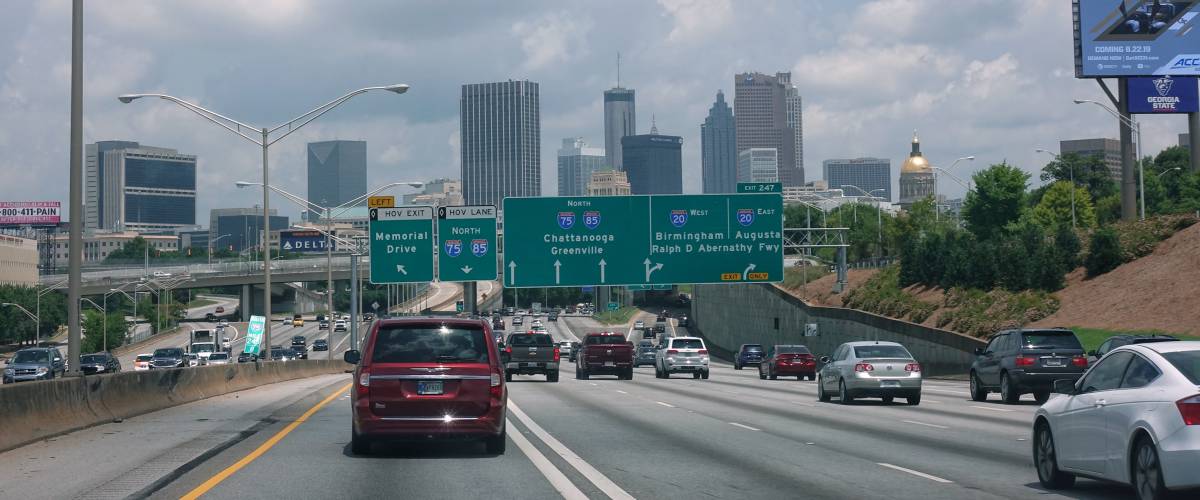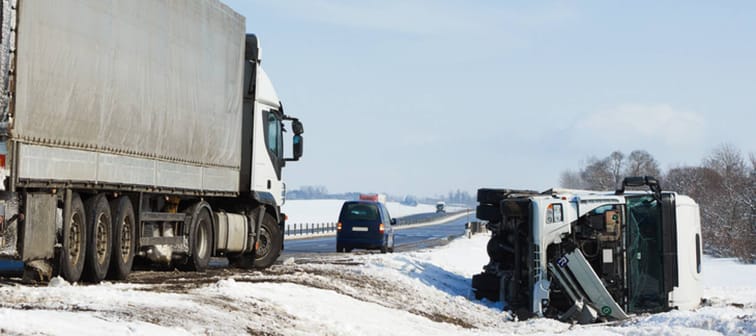10. U.S. 41

The only noninterstate highway on the list, U.S. 41 runs southwest from Michigan’s upper peninsula through Milwaukee; Chicago; Nashville, Tennessee; and Atlanta, all the way down to Miami.
On the northern end, snowstorms and ice wreak havoc on the road. And on the southern end, you have Hillsborough County in Florida, the region with the highest rate of traffic fatalities in the country.
The National Highway Traffic Safety Administration reports 141 fatal accidents and 7.02 fatalities per 100 miles along U.S. 41 in 2019.
Stop overpaying for home insurance
Home insurance is an essential expense – one that can often be pricey. You can lower your monthly recurring expenses by finding a more economical alternative for home insurance.
SmartFinancial can help you do just that. SmartFinancial’s online marketplace of vetted home insurance providers allows you to quickly shop around for rates from the country’s top insurance companies, and ensure you’re paying the lowest price possible for your home insurance.
Explore better rates9. I-80
The I-80 is one of the longest highways in the United States, spanning 2,900 miles from San Francisco to Teaneck, New Jersey.
The combination of high speed limits, high semitruck traffic and high winds in certain areas help make I-80 an especially dangerous road.
In 2019, the highway saw 7.21 fatalities per 100 miles and a total of 209 deaths.
8. I-70
The I-70 stretches east-to-west from Utah to Maryland, passing through Denver, St. Louis, Indianapolis, Pittsburgh and Baltimore.
It saw 158 deaths in 2019, or 7.35 deaths per 100 miles.
Certain parts of the interstate — like the section passing through Colorado — include steep grades, sharp turns and severe weather. The scenery is beautiful, but don’t try to snap a photo on the road.
Stop overpaying for home insurance
Home insurance is an essential expense – one that can often be pricey. You can lower your monthly recurring expenses by finding a more economical alternative for home insurance.
SmartFinancial can help you do just that. SmartFinancial’s online marketplace of vetted home insurance providers allows you to quickly shop around for rates from the country’s top insurance companies, and ensure you’re paying the lowest price possible for your home insurance.
Explore better rates7. I-40

The I-40 spans east-to-west from Barstow, California, to Wilmington, North Carolina, passing through Albuquerque, New Mexico; Oklahoma City; Nashville; and Raleigh, North Carolina, along the way.
It was the highway with the second-most total fatalities, 253, but because of its great length, that only comes to 9.89 deaths per 100 miles.
It’s been ranked one of the most dangerous highways in almost every state it passes through due to the sheer number of drivers who use it, especially during the summer.
6. I-15
Interstate 15 meanders from Sweetgrass, Montana, through Salt Lake City, Las Vegas and Los Angeles going all the way down to San Diego.
Although the stretch between Las Vegas and Los Angeles is a straight line in the desert, allowing drivers to see for miles, it’s regularly called out as one of the deadliest passes in the country due to speeding and other bad behavior.
Read more: The 10 best investing apps for 'once-in-a-generation' opportunities (even if you're a beginner)
The total death count was 158, which is less than many other highways on the list. But since it covers a relatively short distance, that’s 11.02 fatalities per 100 miles.
5. I-35
The I-35 extends north to south from Duluth, Minnesota, down to Laredo, Texas.
Many of the 197 deaths (that’s 12.56 per 100 miles) occured in Texas, where the I-35 passes through San Antonio, Dallas and Austin, three of the most populated cities in the nation.
It’s also a common route for semitrucks, whose great bulk can cause serious accidents.
4. I-75

I-75 starts near Michigan’s Mackinac Bridge and runs southwest to Miami, hitting Detroit, Cincinnati, Atlanta, Tampa and several other major cities along the way.
Many of the highway’s 237 deaths (13.27 per 100 miles) fell on the two extremes of the interstate — on Michigan’s slick winter roads and Tampa’s accident-prone streets.
3. I-5
The I-5 is the main highway that runs north-to-south along the West Coast. It saw 186 fatalities in 2019, or 13.47 deaths per 100 miles.
The common route for 18-wheelers is the only continuous interstate that hits both Canada and Mexico borders, starting in Blaine, Washington, and ending in San Ysidro, California.
California’s huge population naturally leads to a lot of traffic, and the I-5 spans the entire length of the state, passing by Sacramento, Los Angeles and San Diego.
2. I-20
The I-20 is a short but deadly interstate highway that runs east-to-west through Texas, Louisiana, Mississippi, Alabama, Georgia and South Carolina.
The interstate is only about 1,539 miles long — but at 208 fatalities, that becomes an alarming rate of 13.52 deaths per 100 miles.
One major factor? The route intersects several high-traffic areas, including Dallas; Jackson, Mississippi; and Atlanta.
1. I-95

Interstate 95 starts at the Canadian border in Maine, passing through Boston, New York City, Baltimore and Jacksonville, Florida, before ending in Miami.
Think of it as the East Coast bookend to the West Coast’s I-5.
It ranks highest for both total fatalities (284) and fatalities per 100 miles (14.88) — due in large part to harsh Northeast winters and a flurry of crashes along the east coast of Florida.
How to protect yourself

Even if you don’t regularly drive on one of these 10 roads, deaths are up across the country, with an estimated 20,160 people killed in the first half of 2021, according to the U.S. Department of Transportation. That’s up 18.4% year-over-year, making it the biggest jump on record.
You’ll want to do whatever you can to reduce your chances of getting in a wreck.
Yes, that means keeping a good distance from the car ahead, being more vigilant at night, not multitasking behind the wheel, and leaving early so you aren’t in a rush.
But no matter how well you drive, rocketing around in 3,500 pounds of metal comes with inherent risks. That’s what car insurance is for.
However, in some states, minimum coverage doesn’t help you much if you get into a serious accident. Before hitting the road, make sure you read over your policy to ensure you have a sense of what it covers — and what it doesn't.
And if you're not happy with the coverage you get at your price point? It's time to shop around for a better policy.
While most insurers examine the same details to calculate your premiums, they each have their own proprietary (and secret) methods of assessing your details. Which means you should shop around and compare multiple quotes from different providers gives you the best chance of getting you the coverage you need — at a price point you can be comfortable with.
Sponsored
Unexpected vet bills don’t have to break the bank
Life with pets is unpredictable, but there are ways to prepare for the unexpected.
Embrace Pet Insurance offers coverage for treatment of accidents, illnesses, prescriptions drugs, emergency care and more.
Plus, their optional wellness plan covers things like routine vet trips, grooming and training costs, if you want to give your pet the all-star treatment while you protect your bank account.






